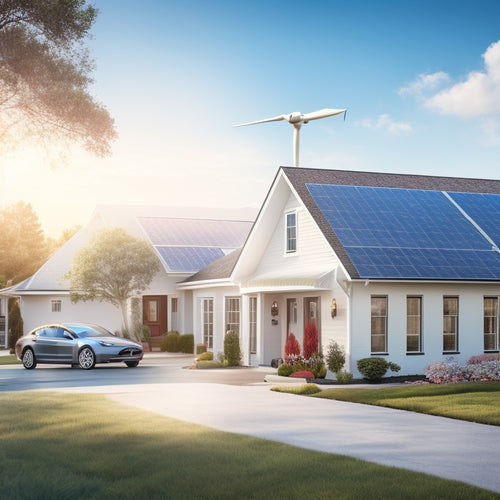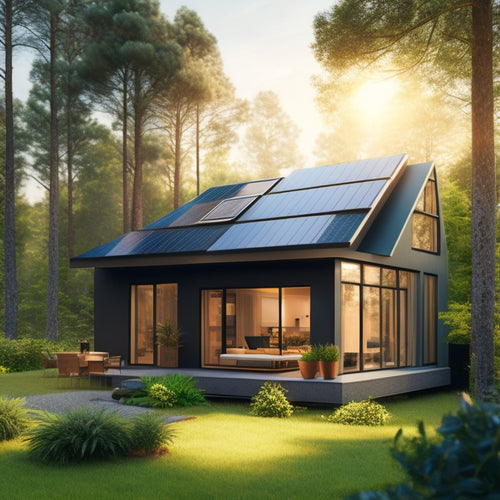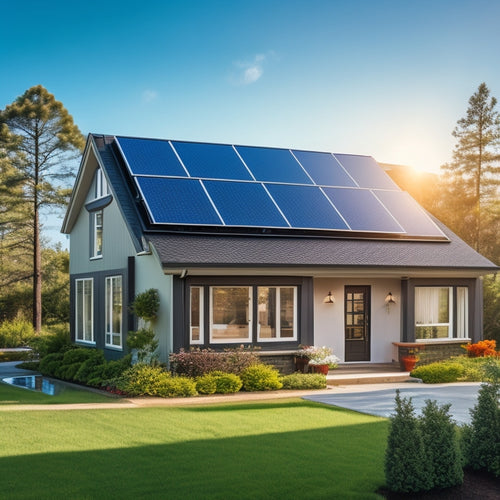
What Are the 5 Essential Costs in Solar Battery Storage System Cost Breakdown
Share
When evaluating the cost of a solar battery storage system, you'll find that five essential categories of expenses dictate the overall price tag. You'll need to examine hardware and component costs, which vary depending on the type of battery and inverter chosen. Installation and labor costs will depend on the installer's skill level and local rates. Inverter and converter costs range from $1,000 to $5,000, while monitoring and maintenance fees can add up to $1,000 annually. Finally, balance of system costs include everything else, from mounting systems to electrical infrastructure. As you investigate each of these categories, you'll gain a deeper understanding of what drives the total cost.
Key Takeaways
- Hardware and component costs, including batteries, inverters, and converters, significantly impact the overall expense of a solar battery storage system.
- Installation and labor costs vary based on installation techniques, system complexity, and local rates, with experienced installers potentially charging higher rates.
- Inverter and converter costs range from $1,000 to $5,000, depending on specifications and brand, and are essential for efficient energy conversion.
- Monitoring and maintenance fees, including annual inspections, performance tracking, and software updates, are necessary for optimal system operation and can range from $50 to $500.
- Balance of system costs, including mounting and tracking systems, electrical infrastructure, and system monitoring, are additional expenses to consider in a solar battery storage system cost breakdown.
Hardware and Component Costs
Your solar battery storage system's hardware and component costs are a significant factor in the overall expense. These costs vary greatly depending on the type and quality of components you choose.
Battery types, such as lead-acid, lithium-ion, or saltwater batteries, differ in their efficiency ratings, lifespan, and price points. For instance, lithium-ion batteries are more expensive upfront but offer higher efficiency ratings and longer lifetimes compared to lead-acid batteries.
Moreover, the inverter and converter components also impact the overall cost. High-efficiency inverters with advanced features like grid-tie functionality and monitoring capabilities come at a higher cost.
In addition, the system's monitoring and control systems, including sensors and software, contribute to the overall hardware and component costs. When selecting components, you'll need to balance upfront costs with long-term benefits, such as increased efficiency and extended system lifespan.
Installation and Labor Costs
As you balance the trade-offs between different components, it's equally important to reflect on the labor costs involved in installing your solar battery storage system.
These costs can vary greatly depending on the installation techniques used, the complexity of the system, and the labor rates in your area.
When hiring an installer, you'll want to evaluate their level of skill, certifications, and reputation. More experienced installers may charge higher labor rates, but they'll likely complete the job more efficiently and with fewer mistakes.
In addition, they may offer warranties or guarantees that can provide peace of mind.
Labor costs can also be influenced by the system's size and complexity. Larger systems or those with multiple components may require more labor hours, increasing the overall cost.
Moreover, installations that require specialized skills, such as electrical engineering or custom programming, may command higher labor rates.
To get an accurate estimate of installation and labor costs, be sure to get quotes from multiple installers and ask about their installation techniques, labor rates, and any additional fees or charges.
Inverter and Converter Costs
Frequently, the inverter and converter components of a solar battery storage system are overlooked, yet they play an essential role in converting DC power from the solar panels and storing it in the battery.
You'll need to invest in a high-quality inverter that guarantees efficient energy conversion. Look for an inverter with high inverter efficiency, typically above 95%, to minimize energy losses.
There are different types of converters, including DC-DC converters and AC-DC converters. DC-DC converters are used to step up or step down the voltage levels, while AC-DC converters convert the AC power from the grid to DC power for charging the battery.
You may also require a bi-directional converter that can handle both grid-tie and off-grid operations.
When selecting an inverter and converter, consider factors such as compatibility with your solar panels and battery type, maximum power output, and durability.
A high-quality inverter and converter can cost anywhere from $1,000 to $5,000, depending on the specifications and brand. It's vital to balance cost with performance to guarantee your solar battery storage system operates efficiently and effectively.
Monitoring and Maintenance Fees
Monitoring and maintenance fees are a necessary aspect of guaranteeing your solar battery storage system operates at peak levels. These costs cover the expenses associated with regularly inspecting and servicing your system to prevent faults, optimize performance, and extend its lifespan. By investing in monitoring and maintenance, you can identify potential issues before they become major problems, reducing downtime and saving you money in the long run.
Here's a breakdown of typical monitoring and maintenance costs:
| Service | Frequency | Cost |
|---|---|---|
| Annual inspection | Annually | $200-$500 |
| Performance tracking and analysis | Quarterly | $100-$300 |
| Software updates and remote monitoring | Ongoing | $50-$100/month |
Regular monitoring and maintenance are essential for performance tracking, system longevity, and identifying potential issues early on. By factoring these costs into your overall budget, you can guarantee your solar battery storage system continues to operate efficiently and effectively over its lifespan.
Balance of System Costs
You'll need to factor in balance of system costs when calculating the total expense of your solar battery storage system.
These costs encompass all the components that make your system efficient and functional, excluding the solar panels and battery.
Here are the key balance of system costs to evaluate:
-
Inverters: Convert DC power from your solar panels to AC power for your home, and synchronize with the grid.
-
Mounting and tracking systems: Secure your solar panels and optimize their angle to maximize energy production.
-
Electrical infrastructure: Includes wiring, switches, and circuit breakers that connect your solar panels to the battery and the grid.
- System monitoring and control systems: Enable real-time tracking of your system's performance, allowing for swift issue detection and resolution.
As technology advancements improve system efficiency, these costs are decreasing.
However, they still play a significant role in the overall expense of your solar battery storage system.
Frequently Asked Questions
Can I Install a Solar Battery Storage System Myself?
You can attempt a DIY installation, but it's essential you prioritize safety considerations, ensuring a secure and compliant setup, as improper connections can lead to electrical shocks, fires, or even system failure, compromising your investment.
Are Solar Battery Storage Systems Compatible With All Homes?
You're probably thinking every home is a perfect fit for solar battery storage, but surprisingly, not all homes are created equal when it comes to solar compatibility; you'll need to meet specific installation requirements, like adequate roof space and a suitable electrical panel, to guarantee a seamless integration.
How Long Does a Typical Solar Battery Last?
You're likely wondering how long your solar battery will last. Typically, a solar battery's lifespan ranges from 10 to 15 years, depending on factors like depth of discharge, charging cycles, and environmental conditions that affect its longevity factors.
Can I Use Multiple Types of Solar Batteries in One System?
You'll be surprised to know that 70% of solar battery users upgrade their systems within 5 years. When combining multiple battery types, you'll need to verify system compatibility, so research and understand the technical specifications of each battery type to assure seamless integration.
Are There Any Government Incentives for Solar Battery Storage Systems?
You're eligible for government incentives, such as rebates and tax credits, which can greatly reduce your solar battery storage system's upfront cost, making it more affordable and increasing your return on investment.
Conclusion
As you commence your solar battery storage expedition, remember that every penny counts. The 5 essential costs - hardware, installation, inverter, monitoring, and balance of system - are the pillars that hold your system's financial foundation. Like an ancient phalanx formation, each component stands strong, yet vulnerable to cracks without the others. Make certain you've accounted for each cost, lest your renewable dreams crumble under the weight of financial reality.
Related Posts
-

Why Homeowners Are Embracing DIY Energy Independence
By taking control of your energy needs, you're breaking free from the uncertainty of utility bills and embracing a se...
-

Reduce Solar Panel Cost for Your Small Home
By evaluating your energy needs, choosing the right installer, and selecting cost-effective solar panel options, you ...
-

Solar Power Units Perfect for Homes
You're considering installing a solar power unit in your home, a decision that can notably reduce your reliance on tr...


